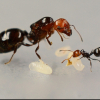Found near Boise, Idaho measuring 1 & 1/2 cm in length:

I'm pretty sure that is Camponotus pennsylvanicus.
I thought so too but they are only on the east coast not the west in Idaho!
Colonies:
One Formica Podzolica queen in a test tube setup.
Seems to small for pennsylvanicus
This is Camponotus laevigatus most likely, but with those pictures you cannot be 100% sure.
Hi there! I went on a 6 month or so hiatus, in part due, and in part cause of the death of my colonies.
However, I went back to the Sierras, and restarted my collection, which is now as follows:
Aphaenogaster uinta, Camponotus vicinus, Camponotus modoc, Formica cf. aserva, Formica cf. micropthalma, Formica cf. manni, Formica subpolita, Formica cf. subaenescens, Lasius americanus, Manica invidia, Pogonomyrmex salinus, Pogonomyrmex sp. 1, Solenopsis validiuscula, & Solenopsis sp. 3 (new Sierra variant).
It seems like it could only be C. Modoc or C. Laevigatus. The C. Modoc has red legs and my queen does not so it must be C. Laevigatus.
Colonies:
One Formica Podzolica queen in a test tube setup.
So do you think that it is a C. Laevigatus?
Edited by antboyidaho, May 23 2021 - 2:07 PM.
Colonies:
One Formica Podzolica queen in a test tube setup.
The queen does seem shiny and smooth like the C. Laevigatus does though
Colonies:
One Formica Podzolica queen in a test tube setup.
0 members, 1 guests, 0 anonymous users